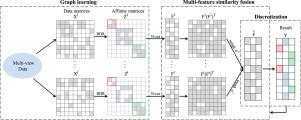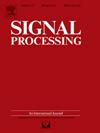One-step multi-view spectral clustering based on multi-feature similarity fusion
IF 3.4
2区 工程技术
Q2 ENGINEERING, ELECTRICAL & ELECTRONIC
引用次数: 0
Abstract
Multi-view clustering has attracted increasing attention for handling complex data with multiple views or sources. Among them, spectral clustering-based methods become more and more popular due to it can make full use of information from different views. However, most existing multi-view spectral clustering methods typically adopt a two-step scheme, which firstly obtains the spectral embedding matrix through graph fusion or multi-feature fusion, and then uses the k-means algorithm to cluster the spectral embedding matrix to obtain the final clustering result. This two-step scheme inevitably leads to information loss, resulting in a suboptimal solution. Furthermore, the methods of graph fusion and multi-feature fusion have not taken into account the inconsistency of features between different views and the unordered nature of clustering labels, which also decreases the clustering performance. To solve these problems, we propose a novel one-step multi-view spectral clustering based on multi-feature similarity fusion. This model simultaneously conducts graph learning, multi-feature similarity fusion and discretization in a unified framework, which can mutually negotiate and optimize each other to achieve better results. Furthermore, compared to directly fusing affinity matrices or spectral embedding matrixs from different views, we take advantage of the property of the spectral embedding matrix, fuse the similarity of samples in feature space, better handle the differences between different views. Finally, the superiority of our method is verified by the experimental evaluation of several data sets. The demo code of this work is publicly available at https://github.com/kong-de-zheng/MOMSC.

基于多特征相似性融合的一步式多视角光谱聚类
多视图聚类方法在处理具有多个视图或来源的复杂数据方面受到越来越多的关注。其中,基于光谱聚类的方法由于能充分利用不同视图的信息而越来越受欢迎。然而,现有的多视图光谱聚类方法大多采用两步法,即首先通过图融合或多特征融合得到光谱嵌入矩阵,然后使用 k-means 算法对光谱嵌入矩阵进行聚类,得到最终的聚类结果。这种两步走的方案不可避免地会导致信息丢失,从而产生次优解。此外,图融合和多特征融合方法没有考虑到不同视图之间特征的不一致性和聚类标签的无序性,这也降低了聚类性能。为了解决这些问题,我们提出了一种基于多特征相似性融合的新型一步式多视图光谱聚类。该模型在一个统一的框架中同时进行图学习、多特征相似性融合和离散化,可以相互协商和优化,从而达到更好的效果。此外,与直接融合不同视图的亲和矩阵或光谱嵌入矩阵相比,我们利用了光谱嵌入矩阵的特性,在特征空间中融合样本的相似性,更好地处理了不同视图之间的差异。最后,我们通过多个数据集的实验评估验证了我们方法的优越性。这项工作的演示代码可在 https://github.com/kong-de-zheng/MOMSC 上公开获取。
本文章由计算机程序翻译,如有差异,请以英文原文为准。
求助全文
约1分钟内获得全文
求助全文
来源期刊

Signal Processing
工程技术-工程:电子与电气
CiteScore
9.20
自引率
9.10%
发文量
309
审稿时长
41 days
期刊介绍:
Signal Processing incorporates all aspects of the theory and practice of signal processing. It features original research work, tutorial and review articles, and accounts of practical developments. It is intended for a rapid dissemination of knowledge and experience to engineers and scientists working in the research, development or practical application of signal processing.
Subject areas covered by the journal include: Signal Theory; Stochastic Processes; Detection and Estimation; Spectral Analysis; Filtering; Signal Processing Systems; Software Developments; Image Processing; Pattern Recognition; Optical Signal Processing; Digital Signal Processing; Multi-dimensional Signal Processing; Communication Signal Processing; Biomedical Signal Processing; Geophysical and Astrophysical Signal Processing; Earth Resources Signal Processing; Acoustic and Vibration Signal Processing; Data Processing; Remote Sensing; Signal Processing Technology; Radar Signal Processing; Sonar Signal Processing; Industrial Applications; New Applications.
 求助内容:
求助内容: 应助结果提醒方式:
应助结果提醒方式:


